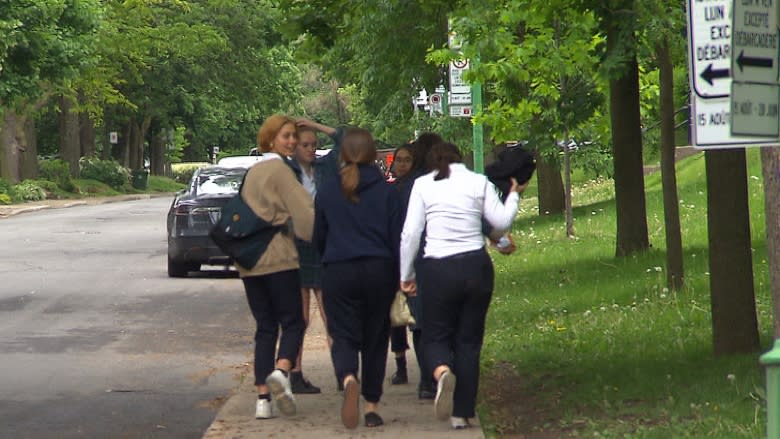The fight to go braless: Montreal students push back against school's directive
Students at Le Pensionnat du Saint-Nom-de-Marie — an all-girls private school in Outremont — have launched a petition advocating for the freedom not to wear a bra at school.
The petition had garnered more than 1,600 signatures by Tuesday morning.
The movement grew out of an incident that happened at the school last week in which, according to the text of the petition, a student was asked to cover up because she wasn't wearing a bra under her T-shirt.
"Since Sec. 1, we've been told that we will be taught to be citizens of the world and that being a woman doesn't limit us, but how do these conservative approaches fit in?" reads the petition.
Eva Meloche, a 15-year-old student at the Pensionnat du Saint-Nom-de-Marie who signed the petition, supports the cause.
"I think we should have the choice if we want wear a bra or not," she told CBC.
Meloche said she doesn't think the school is completely in the wrong but that the concern about the student's undergarment could have been handled differently.
"To call in a student and ask them to cover themselves up makes them feel uncomfortable."
Meloche said she spoke with her mother about the incident, and she agreed the petition was a good idea.
Yanna Garnier, another 16-year-old student, signed the petition and said she'd be happy to see a more lenient stance from the school.
"Women are not obligated to wear a bra even at school," she told CBC. "We [should] have the choice to decide whether we want to wear one or not."
School responds
According to a letter sent home to parents by the school's administration on Friday, the school's dress code doesn't include a formal rule about wearing a bra.
"We remind you that the dress code aims above all else to establish certain guidelines," said the head of the school, Yves Petit, in the letter. "There is no mention of the wearing of undergarments. However, it's always a matter of judgment."
Petit said that "the staff must intervene when an outfit is deemed indecent (while being aware that the question is subjective)."
He wrote that the issue goes beyond what happened at the school, "that is to say, a societal debate on the equality of men and women, as it pertains to their bodies."
In an interview with CBC News, Petit said that the school administration wants to encourage the girls to speak up and challenge ideas, but the school retains the right to exercise discretion, on a case by case basis.
Petit said that the incident that sparked the response from students happened on Thursday at an out-of-uniform student life activity held outside.
He said a female school administrator took the student aside to explain that the outfit wasn't appropriate.
Despite the pushback, Petit said that staff will continue to intervene if they deem a student to be dressed inappropriately.
Hélène David, the minister responsible for the status of women, spoke outside the National Assembly Tuesday, calling the girls behind the petition "extraordinary." She said that they are asking "important questions."
David said that as the MNA for Outremont, she is familiar with the school and its students and staff.
"People were feeling a little bit uneasy, and they asked her to put something on," she said. "But the debate is about what we can wear, what we shouldn't wear. The important part is to have a dialogue."
A growing movement
This is not the first time Quebec students have raised the complaint of mandatory bra-wearing at school.
In April, high school students at a dozen schools across the province were wearing yellow felt squares pinned to their jackets to protest dress codes.
Students at Joseph-François-Perrault de Québec school staged a braless protest this spring, and managed to convince the school to relax some of its policies.
Students taking part in the yellow square movement told CBC that the fight was about more than just fashion choices.
The students said they wanted to push the administration to look at its policies and ensure they were treating male and female students equally.
They also wanted to address the hypersexualization of female students in an educational environment.



